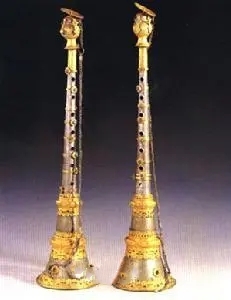Reform Sournay
In the early 1980s, Song Baocai, a wind musician of the Central National Song and Dance Ensemble, had a folk-made Surnai gifted by a friend. When he was playing, he felt that the sound was not correct, so he took it to the Beijing National Musical Instrument Factory and asked Wu Zhongfu, a wind music producer, to repair it. When Master Wu saw this wind instrument from Xinjiang, he felt that not only the inner diameter was not round, but also the hole spacing was not standardized, so he wanted to make a new Surnai on the basis of the original shape.

After more than two years of research and trial production, the C-tuned reform Sournay was finally completed. The overall height is 50 cm, the tube height is 33 cm, the inner diameter of the upper mouth is 1.15 cm, the inner diameter of the lower mouth is 2.2 cm, the height of the bell mouth is 9.3 cm, and the outer diameter of the bell mouth is 7 cm. The pipe body is best made of cypress, and the pipe wall should not be too thick. The original irregular average hole is changed to a twelve-average hole system, which reduces the inner diameter of the pipe body. In terms of appearance decoration, the top of the cylindrical tube is changed to the shape of the top floor of a mosque, and a pattern rich in ethnic style is carved on the periphery of the bell mouth. This reform of Surnai has been used in the instrumental ensemble and singing and dancing accompaniment of the Central National Song and Dance Troupe.
 渝公网安备 50010702504639号
渝公网安备 50010702504639号